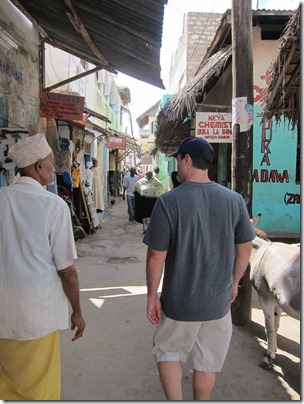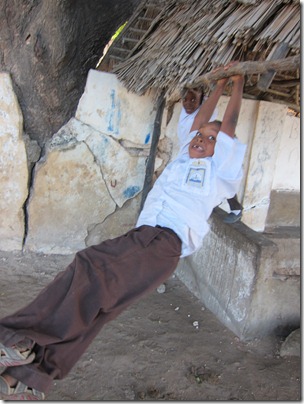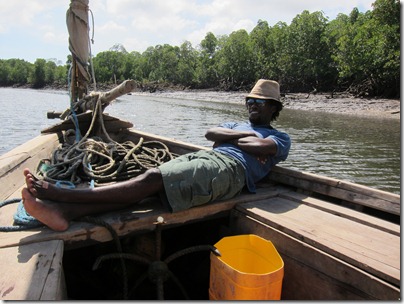 We’re reaching the end of our stay in Lamu. This is really a charming little pocket of the world where ancient culture mixes with modern technology; stands selling cell phones sit side-by-side with cages of live chickens. Open drainage gutters run past Internet cafes.
We’re reaching the end of our stay in Lamu. This is really a charming little pocket of the world where ancient culture mixes with modern technology; stands selling cell phones sit side-by-side with cages of live chickens. Open drainage gutters run past Internet cafes.
 The people are for the most part wonderfully charming and helpful. “This is Lamu,†said one man who led us through the maze of streets one night in search of a tailor (named Elizabeth…it took me a few minutes to put that one together), “we help each other.†We ended up at her house—she wasn’t home, but we got a detailed description of how to find her shop the next day. On another occasion what started as a seemingly simple trip to the post office resulted in a sort of help-doubling situation where every step of the process collected another group of locals who chipped in with wrapping, taping, weighing, unwrapping, verifying the contents, filling out paperwork, wrapping again, taping again, weighing again, and finally sending.
The people are for the most part wonderfully charming and helpful. “This is Lamu,†said one man who led us through the maze of streets one night in search of a tailor (named Elizabeth…it took me a few minutes to put that one together), “we help each other.†We ended up at her house—she wasn’t home, but we got a detailed description of how to find her shop the next day. On another occasion what started as a seemingly simple trip to the post office resulted in a sort of help-doubling situation where every step of the process collected another group of locals who chipped in with wrapping, taping, weighing, unwrapping, verifying the contents, filling out paperwork, wrapping again, taping again, weighing again, and finally sending.
One young man was particularly helpful. There always seems to be a helpful young man everywhere you go who will not only translate and send you in the right direction, but will take you from place to place until you have what you’re looking for. He mentioned that he sells imported wine, so we figured we’d show our appreciation by purchasing a bottle. On the way to his house, Michelle asked if he had any children.
“Yes, a son. He’s four-and-a-half. But he’s in the hospital; his kidneys. Doctors say it’s very bad.â€
“We’re sorry.â€
“Hakuna matada. That is life.â€
When he brought us the wine, he also handed us a letter from the doctor with a donation sheet stapled to the back. Acute renal failure; a transplant is possible, but the cost is $5000. We gave what we had—a pittance given the amount he needs to raise. A sad story that highlights a sad truth—even in this relatively prosperous, tourist-friendly town, raising $5000 for anything is a daunting proposition.
 Which makes it difficult to argue against a new deep-sea port that is being planned for a town a few miles up the coast from Lamu. The port is largely funded by Chinese investors and will provide a direct link between Kenya and the rich oil resources of Somalia.
Which makes it difficult to argue against a new deep-sea port that is being planned for a town a few miles up the coast from Lamu. The port is largely funded by Chinese investors and will provide a direct link between Kenya and the rich oil resources of Somalia.
It will be an environmental nightmare. We went snorkeling yesterday in the channel that the ships will use as they come and go. A lot of the coral has already been ravaged by increased boat traffic, and the rest will have to be dredged to make room for the huge tankers and container ships. An entire small island will apparently be eliminated.
More people will descend on Lamu; workers from “Nai-robbery,†sailors from the ships docked at the port. The charms of the town—its conservative Muslim traditions, the innocent friendliness of the residents, donkey-dominated commerce and trade—could be at risk.
Our dhow captain for the snorkeling trip was more optimistic, hoping that a new town will grow at the port that will provide enough of a distraction to protect the spirit of Lamu that has hardly changed in two millennia. Maybe he’s right, maybe not. But it will bring jobs and money and a host of new of opportunities; and it might just mean that one more four-year-old will be able to walk out of the hospital on his own.
I read that Lamu is a UNESCO world heritage site…is it not protected against port development somehow?
A very thoughtful post…
When admiring history and parts of the world left untouched by time, there is always a tension between the benefits of modern society and the desire to preserve both the simple life, and the historical relics.
I hope the rest of your trip is as inspiring and thought provoking,
Craig
I really want to be there to help that little boy. What a very profound experince you are having. Thank you for taking us along.
lyf,
m
Lamu Town is a UNESCO heritage site, but the port is being built far enough away that UNESCO’s protection probably has no effect (although Michelle points out that the port is being built adjacent to a marine national reserve, so…). The concern is that the port will have all sorts of spillover effects that have a significant impact on Lamu Island and Lamu Town in particular.